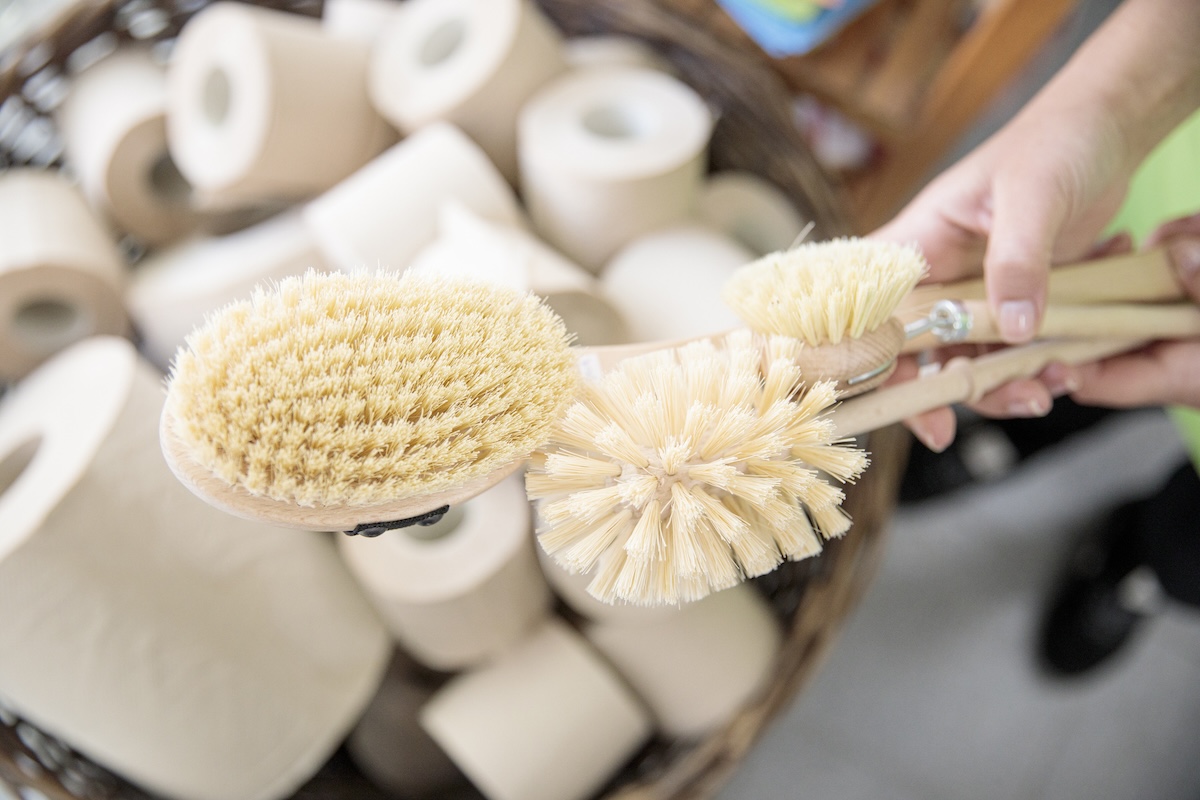Plastic is a huge part of our daily routine, making our lives more convenient. But many of us don’t realize how prevalent plastic is in our home—in everything from clothing to cookware to cleaning supplies. Besides the devastating amount of waste resulting from over 460 million metric tons of plastic produced each year globally, according to the United Nations Environment Programme, there are also health concerns to consider.
Convenient plastic products like water bottles and food containers break down over time into tiny pieces less than 5 millimeters in size called microplastics. Consumer products like synthetic clothing fabric, cleaners, toothpaste, and skincare (e.g., microbeads) also contain the plastics. Microplastics can even appear as dust in our homes.
Unfortunately, microplastics made from harmful chemicals like BPA (bisphenol A) and forever chemicals like PFAS (per- and polyfluoroalkyl substances) are showing up more often in the water we drink and food we eat, and even making their way into our bodies. This has raised a red flag about the health damage that can result, including developmental, reproductive, and hormonal problems.
As more people recognize these risks, it’s important to figure out how to avoid microplastics. Here are some steps you can take to reduce your exposure to microplastics in your home and boost home health and safety.
Avoid single-use plastics.
Plastics can take hundreds or even thousands of years to decompose. By avoiding using plastic products in the first place, you can make a dent in the amount of microplastics in the environment overall. This is especially critical with single-use plastics, or items meant to be used only once and then thrown away, like straws and take-out food containers.
One study revealed that some plastic water bottles contain as many as 10,000 microplastic particles. Some locations have banned single-use products, but it’s really up to individuals to shift how much they use.
Here are a few ways to reduce single-use plastics in your life:
- Eat more fresh produce, such as by shopping at farmers markets, instead of items sold in plastic packaging.
- Replace single-use plastic water bottles with refillable BPA-free ones.
- Bring your own fabric bags when shopping.
- Ask for paper instead of plastic bags.
- Look for zero-waste grocery stores and other eco-conscious retailers.
- Swap disposable plastic straws for reusable metal, glass, or bamboo straws.
Change up your laundry routine.

Switching how you do laundry can significantly reduce the amount of microplastics produced in your home. As clothes tumble around in the washer and dryer, fibers can break down and shed microplastics. Synthetic fabrics made from plastic, such as polyester, acrylic, and nylon, are the biggest culprits, releasing hundreds of thousands of microplastics per load.
Here are some adjustments you can make:
- Wash your clothing less often, and wash only full loads with cold water on a short cycle.
- Buy items made of natural fabrics like silk, wool, bamboo, organic cotton, and hemp instead of synthetics.
- Opt for unscented liquid detergent since powder detergent can be abrasive.
- Install a fiber-catching filter in your laundry machine to keep microplastics from washing out with the wastewater.
- Invest in a microfiber laundry bag to trap microplastics.
- Throw in a laundry ball to keep microfibers from breaking off of clothes in the first place.
- Avoid the delicate wash setting, which uses more water than a normal cycle.
- Air-dry clothes using a drying rack or clothesline.
Install an effective water filter.
Unfortunately, microplastics have been detected in our drinking water as well. In fact, a 2019 study revealed that plastic fibers are in nearly 95 percent of samples of U.S. tap water. By installing a water filter, you can address this issue in your own home.
Choose a reverse osmosis water filtration system, known to be the most effective filtering option. Reverse osmosis is a process that uses energy to force water through an extremely thin semi-permeable membrane that separates chemicals from the water. An under-the-sink reverse osmosis system costs about $200 to $300, plus an additional $200 to $300 a year to maintain. Whole-house reverse osmosis versions also are available; they can cost thousands of dollars and require a plumber to install them.
Swap nonstick cookware for healthier alternatives.

While nonstick pots and pans add ease to cooking and cleaning afterward, they could be harming your health. A new collaborative study in 2024 found that the synthetic chemicals used in nonstick cookware can release microplastics into food during food preparation. If the coating in Teflon pans, for example, is scratched or broken, millions of microplastics can be released when heated. Choose safer cookware alternatives like cast-iron, ceramic, carbon steel, and stainless steel pans that have stood the test of time.
Choose eco-friendly cleaning supplies.

Conventional cleaning supplies filled with toxic chemicals like bleach, ammonia, and phthalates that are stored in plastic containers can shed tiny plastic particles over time. Replace these cleaners with more eco-friendly brands like those approved by the Environmental Protection Agency’s Safer Choice program or DIY alternatives like baking soda and vinegar.
Additionally, ditch melamine sponges for more eco-friendly options. Recent research shows how melamine foam, such as the material found in the Mr. Clean Magic Eraser sponges, contains microplastics that end up in the water supply, soil, and food chain as the sponges disintegrate. Microfiber dishcloths and kitchen brushes also shed microplastics.
Choose safer alternatives like Swedish dishcloths made from wood pulp and cotton, cellulose sponges made from wood pulp or plant cellulose, coconut scrubbers made from coconut fibers or husks, loofahs made from dried gourds, bamboo brushes made of bamboo and natural bristles, and hemp sponges made of hemp fibers.


